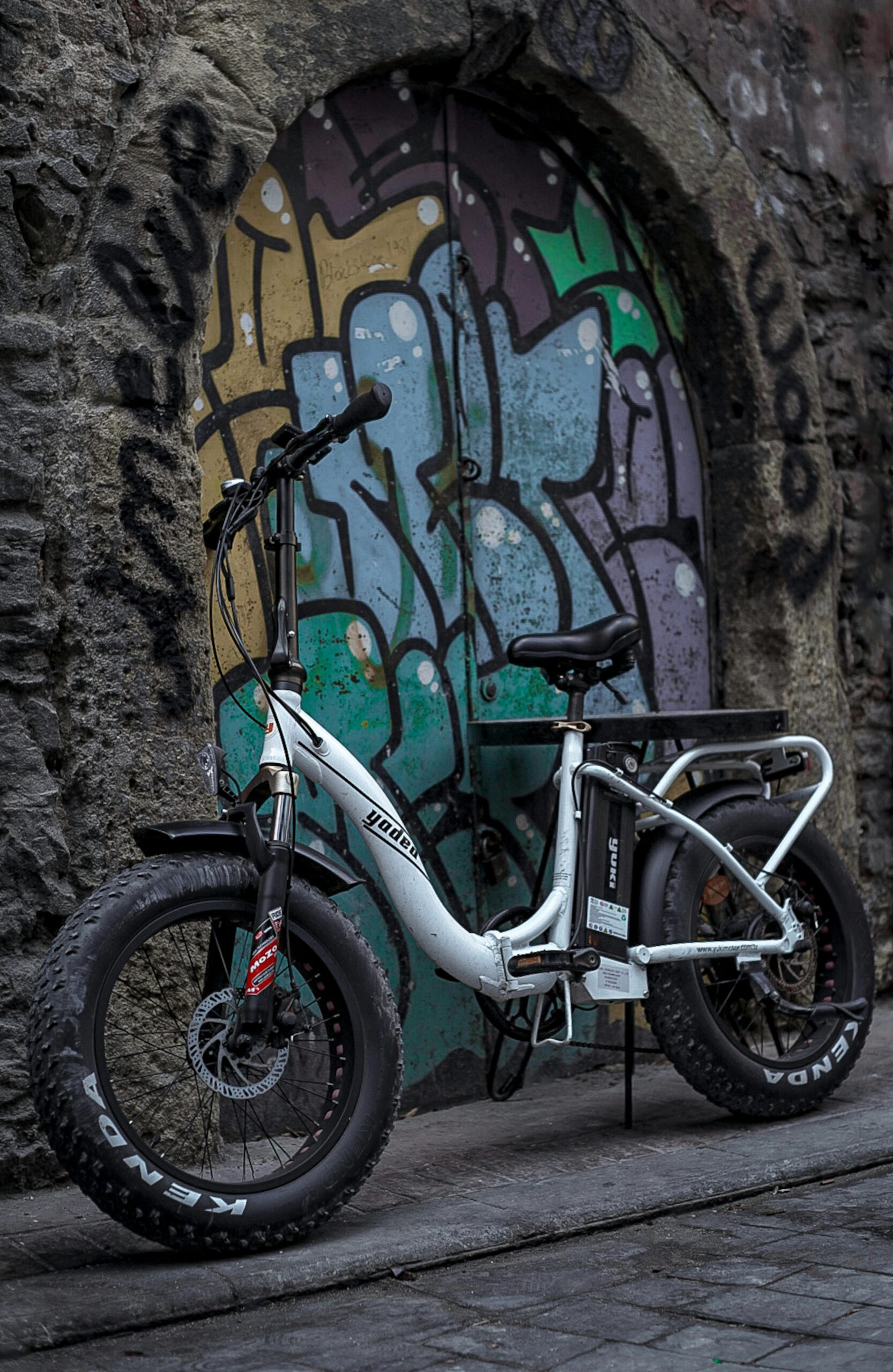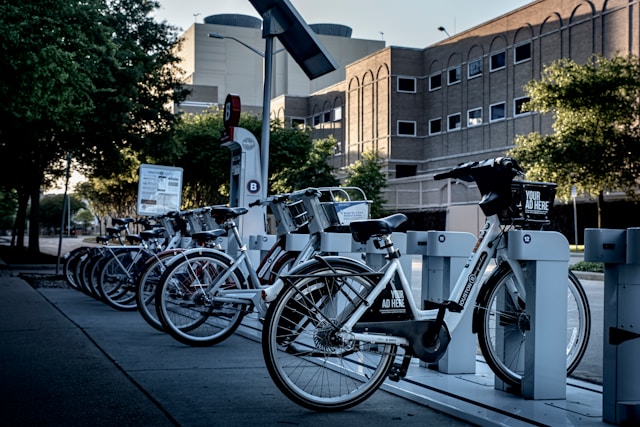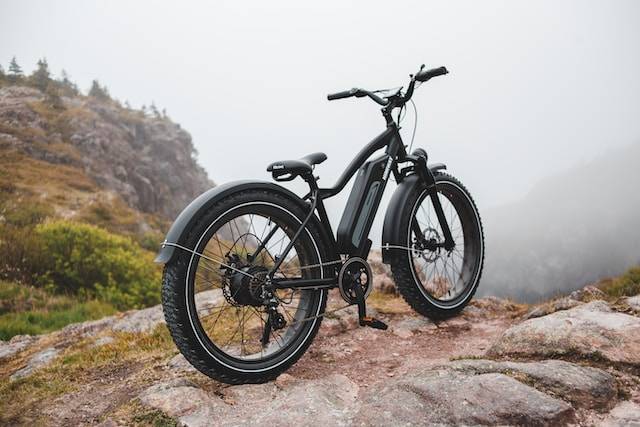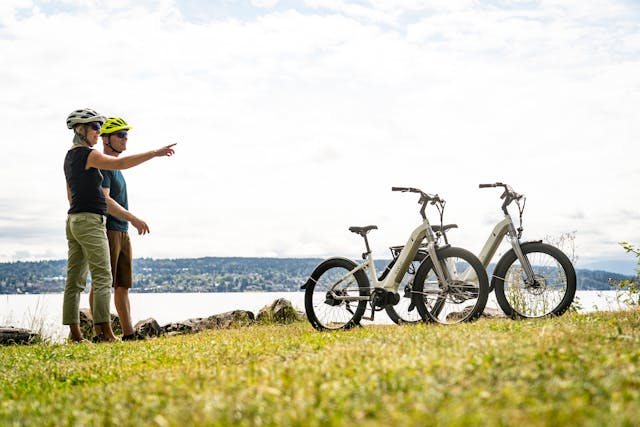Can You Use an Electric Bike for Food Delivery?
Last Updated on June 21, 2024 by Kristina Grant
The world of food delivery has exploded in popularity in recent years. Services like DoorDash and UberEats have made getting our favorite meals delivered to our doorsteps quicker and easier than ever. But for the riders who fulfill these orders, navigating city streets and battling traffic can eat into profits and leave them feeling drained.
Traditional delivery methods have relied on cars and bicycles. Cars, while offering some protection from the elements and the ability to carry larger deliveries, come with significant drawbacks. Gas prices can be a major expense, and getting stuck in traffic can seriously impact delivery times. Bicycles, on the other hand, are a more environmentally friendly option, but they require significant physical effort, especially when tackling long distances or hilly terrain. This can lead to fatigue and limit the number of deliveries a rider can complete in a shift.
However, a new option is gaining momentum: the electric bike, or e-bike. E-bikes offer the perfect blend of human power and electric assistance, creating a recipe for success for food delivery riders. In this blog post, we’ll explore the many advantages of e-bikes for food delivery, from boosting your earnings and efficiency to making the entire experience more enjoyable. Buckle up and get ready to learn how e-bikes can revolutionize your food delivery hustle!
Key Takeaways
- E-bikes cut down on gas costs compared to traditional car-based deliveries, saving you money and reducing your dependence on fossil fuels.
- The agility of e-bikes allows for faster deliveries by navigating traffic jams and busy streets with ease, potentially increasing your earnings per shift.
- E-bikes are a sustainable mode of transportation, producing zero emissions and contributing to a cleaner, healthier environment in the cities you deliver in.
- The pedal-assist feature on e-bikes makes conquering hills and long distances effortless, reducing fatigue and allowing you to arrive at deliveries feeling fresher and ready to take on more orders.
- E-bikes can be customized with racks, baskets, and phone mounts, creating a perfect food delivery setup that caters to your specific needs.
The Advantages of E-bikes for Food Delivery:
E-bikes offer a compelling package of benefits for food delivery riders, making them a recipe for success on multiple fronts. Let’s take a closer look at the economic, environmental, and physical advantages e-bikes bring to the table.
Economic Powerhouse: Saving Money and Boosting Earnings
- Slash Gas Costs: One of the biggest financial burdens for traditional car-based delivery is gas. E-bikes eliminate this expense entirely, relying on electricity to power their motors. With rising gas prices, this translates to significant cost savings for riders.
- Time is Money: Deliver More, Earn More: E-bikes excel in congested urban environments. Their agility allows riders to weave through traffic jams and navigate busy streets with ease, often surpassing car deliveries stuck in gridlock. This translates to faster delivery times and the potential to complete more orders per shift, ultimately boosting your earning potential.
Eco-Friendly Champion: Delivering Deliciousness Sustainably
- Sustainable Transportation: Unlike gas-guzzling cars, e-bikes are a zero-emission mode of transportation. This means no harmful pollutants are released into the air, contributing to a cleaner and healthier environment in the cities you navigate.
- Reduced Carbon Footprint: Every e-bike delivery translates to a smaller carbon footprint compared to a traditional car delivery. By choosing an e-bike, you’re actively participating in a more sustainable food delivery system.
Physical Benefits: Arrive Fresher, Deliver More
- Effortless Hills and Long Distances: Traditional bikes require significant physical exertion, especially when tackling hills or covering long stretches. E-bikes provide a much-needed pedal-assist feature, taking the strain off your legs and making these challenges a breeze.
- Reduced Fatigue, Increased Productivity: The physical ease offered by e-bikes allows you to arrive at deliveries feeling fresher and less fatigued. This translates to increased stamina and the ability to take on more orders throughout your shift.
RELATED CONTENT – Guide to Electric Cargo Bikes for Hauling Groceries and Kids
RELATED CONTENT – Electric Bike Buying Guide
Gearing Up for Success: Choosing the Perfect E-bike for Food Delivery
Now that you’re convinced e-bikes offer a winning formula for food delivery, let’s delve into the practicalities of choosing the right one for your needs. Here are some key considerations to ensure your e-bike becomes your trusty delivery partner.
Selecting Your E-bike: A Balancing Act of Cargo, Power, and Toughness
- Conquering Cargo Challenges: Food deliveries come in all shapes and sizes. Ensure your e-bike can handle your typical load by considering installing racks or baskets. Look for e-bikes with sturdy frames and weight capacities that comfortably accommodate your delivery needs.
- Battery Life Matters: Stay Charged, Stay Delivering: The range of your e-bike’s battery is crucial. Research models with batteries that can handle your average delivery distance without needing a recharge. Remember, factors like terrain and weather can impact battery life, so choose a range that offers some buffer for unexpected situations.
- Built to Last: Durability is Key: Food delivery can be tough on a bike. Choose an e-bike with a robust frame and components that can withstand frequent use and potentially challenging weather conditions. Consider features like puncture-resistant tires and weatherproof components for added peace of mind.
Safety First: Essential Tips for Every Delivery
- Helmet Up, Be Seen: Always wear a properly fitted helmet for your safety. Additionally, invest in reflective gear to increase your visibility on the road, especially during low-light conditions.
- Ride Smart, Ride Safe: Just like any cyclist, obey all traffic regulations and be aware of your surroundings. Maintain a safe distance from other vehicles and pedestrians, and anticipate potential hazards. Remember, a smooth and safe delivery is always the top priority.
Local E-bike Regulations: Knowledge is Power
E-bike regulations can vary by location. In some areas, e-bikes for commercial use may have specific requirements. Before hitting the road for deliveries, take a moment to research any local regulations that might apply to your situation. This ensures you’re operating your e-bike legally and safely.
RELATED CONTENT – Can You Install Bike Racks & Baskets on Electric Bikes?
RELATED CONTENT – 14 Crucial Tips for Electric Bike Safety
Safety Measures and Training
Safety is paramount in any delivery operation, and when it comes to electric bike delivery, it’s essential to address specific safety concerns and implement comprehensive training programs to ensure the well-being of delivery riders and the public. Let’s explore how safety measures and training play a crucial role in electric bike delivery:
Addressing Safety Concerns Related to Electric Bike Delivery:
While electric bikes offer numerous benefits for food delivery, they also present unique safety considerations that must be addressed. One primary concern is the increased speed and agility of e-bikes, which can pose risks to riders and pedestrians if not managed properly. Additionally, navigating through congested urban streets and interacting with other road users requires heightened awareness and caution.
To mitigate these risks, food delivery businesses must implement safety protocols and provide ongoing support to delivery riders. This includes conducting risk assessments, identifying potential hazards, and implementing measures to minimize the likelihood of accidents or injuries. By prioritizing safety, businesses can create a safe and secure environment for their delivery riders and the communities they serve.
Training Programs for Delivery Riders to Ensure Safe Riding Practices:
Effective training programs are essential for equipping delivery riders with the knowledge and skills necessary to safely operate electric bikes. Training should cover a range of topics, including e-bike operation, traffic safety, defensive riding techniques, and emergency procedures. Additionally, riders should receive instructions on how to properly maintain and inspect their bikes to ensure they are in optimal working condition.
Hands-on training sessions and simulations can provide riders with practical experience and help them develop critical decision-making skills in real-world scenarios. Furthermore, ongoing training and refresher courses should be provided to reinforce safe riding practices and address any emerging safety concerns or regulatory changes.
Importance of Protective Gear and Adherence to Traffic Regulations:
Protective gear, such as helmets, reflective clothing, and lights, are essential for ensuring the safety of delivery riders while on the road. Businesses should provide riders with the necessary protective equipment and encourage them to wear it at all times while operating electric bikes. Additionally, adherence to traffic regulations, including speed limits, traffic signals, and right-of-way rules, is crucial for preventing accidents and promoting safe riding behavior.
By emphasizing the importance of protective gear and adherence to traffic regulations, businesses can create a culture of safety and responsibility among their delivery riders. This not only protects riders from harm but also enhances their professionalism and credibility in the eyes of customers and the community.
Safety measures and training are fundamental components of electric bike delivery operations. By addressing safety concerns, providing comprehensive training programs, and promoting adherence to traffic regulations, businesses can ensure the safety of their delivery riders and promote confidence in their delivery services.
Managing E-bike Fleet
Effectively managing an e-bike fleet is essential for ensuring the reliability, safety, and efficiency of food delivery operations. Let’s delve into various strategies for managing an e-bike fleet and maintaining optimal performance:
Exploring Strategies for Managing an E-bike Fleet in Food Delivery Businesses:
Managing an e-bike fleet involves various tasks, including fleet acquisition, maintenance, scheduling, and monitoring. To streamline operations and maximize efficiency, businesses can implement several strategies, such as:
- Fleet Acquisition: Carefully selecting e-bike models that meet the specific needs and requirements of the delivery operation, including factors such as range, load capacity, and durability.
- Fleet Maintenance: Establishing regular maintenance schedules to ensure that e-bikes are properly serviced and inspected for any mechanical issues or wear and tear.
- Scheduling and Dispatch: Developing efficient scheduling and dispatching processes to optimize delivery routes, minimize idle time, and maximize delivery capacity.
- Rider Training: Providing comprehensive training programs for delivery riders to ensure they are proficient in operating e-bikes safely and effectively.
- Performance Monitoring: Implementing systems for monitoring e-bike performance, tracking delivery times, and analyzing data to identify areas for improvement and optimization.
Discussing Maintenance Schedules, Battery Management, and Repair Protocols:
Regular maintenance is critical for keeping e-bikes in optimal working condition and minimizing downtime due to mechanical issues. Maintenance schedules should include routine inspections, lubrication of moving parts, adjustment of brakes and gears, and thorough cleaning to remove dirt and debris.
Battery management is another essential aspect of e-bike fleet management, as the battery is a crucial component that directly impacts the range and performance of e-bikes. Businesses should implement protocols for monitoring battery health, charging cycles, and storage to prolong battery life and ensure reliable operation.
In addition to routine maintenance, businesses should have repair protocols in place to address any unexpected issues or breakdowns promptly. This may involve having a dedicated repair team or outsourcing repairs to certified technicians to minimize disruptions to delivery operations.
Highlighting the Significance of Monitoring Performance and Efficiency:
Monitoring the performance and efficiency of the e-bike fleet is essential for identifying areas for improvement and optimizing delivery operations. Businesses can utilize data analytics and telematics systems to track metrics such as delivery times, distance traveled, energy consumption, and rider performance.
By monitoring performance and efficiency metrics, businesses can identify trends, patterns, and potential bottlenecks in the delivery process. This enables them to make informed decisions and implement strategies to improve delivery times, reduce costs, and enhance overall operational efficiency.
Effective management of an e-bike fleet requires careful planning, regular maintenance, and performance monitoring. By implementing strategies for fleet acquisition, maintenance schedules, battery management, and repair protocols, businesses can ensure the reliability, safety, and efficiency of their delivery operations.
Future Outlook and Growth Potential
The future of electric bike delivery is promising, with significant opportunities for growth and innovation in the rapidly evolving landscape of urban transportation. Let’s explore some insights into the future of electric bike delivery, including potential advancements in technology and infrastructure, as well as the growth potential of e-bike delivery services:
Providing Insights into the Future of Electric Bike Delivery:
As cities continue to grapple with issues such as traffic congestion, air pollution, and the need for sustainable transportation solutions, electric bike delivery is poised to play a pivotal role in addressing these challenges. The continued adoption of e-bikes by food delivery businesses and the expansion of e-bike sharing programs are indicative of the growing acceptance and popularity of this mode of transportation.
In the future, we can expect to see further integration of electric bike delivery into urban logistics networks, with businesses leveraging technology to optimize routes, enhance efficiency, and improve the overall customer experience. Additionally, advancements in battery technology and e-bike design are likely to result in lighter, more powerful, and longer-lasting e-bikes, further enhancing their suitability for delivery applications.
Discussing Potential Advancements in Technology and Infrastructure:
Advancements in technology and infrastructure will play a crucial role in shaping the future of electric bike delivery. We can anticipate the development of smart e-bike systems equipped with GPS tracking, real-time monitoring, and remote diagnostics capabilities, enabling businesses to manage their fleets more efficiently and proactively address maintenance issues.
Furthermore, improvements in charging infrastructure, including the deployment of fast-charging stations and the integration of renewable energy sources, will help support the widespread adoption of electric bikes for delivery purposes. Additionally, investments in dedicated bike lanes, bike-friendly infrastructure, and urban planning initiatives that prioritize active transportation modes will create a more conducive environment for e-bike delivery operations.
Highlighting the Growth Potential of Electric Bike Delivery Services:
The growth potential of electric bike delivery services is vast, driven by factors such as changing consumer preferences, advancements in technology, and the increasing emphasis on sustainability and environmental stewardship. As more businesses recognize the benefits of electric bikes for food delivery, we can expect to see continued expansion and innovation in this sector.
Moreover, the scalability of electric bike delivery makes it accessible to businesses of all sizes, from small local eateries to multinational food delivery platforms. This democratization of delivery services presents opportunities for entrepreneurship and job creation, particularly in urban areas where e-bike delivery can provide an affordable and flexible income-generating opportunity for individuals.
The future of electric bike delivery is bright, with the potential to revolutionize urban transportation, improve air quality, and enhance the overall quality of life in cities around the world. By embracing advancements in technology and infrastructure and capitalizing on the growth potential of e-bike delivery services, businesses can position themselves as leaders in the future of urban mobility and sustainable transportation.
FAQs
1. How far can electric bikes travel on a single charge?
Electric bikes typically have a range of anywhere from 20 to 50 miles on a single charge, depending on factors such as battery capacity, level of assistance used, rider weight, terrain, and weather conditions. Advanced e-bike models with larger battery capacities may offer extended range capabilities, while hilly terrain or frequent stops may reduce the range.
2. Are electric bikes suitable for delivering food in hilly areas?
Yes, electric bikes are well-suited for delivering food in hilly terrain. E-bikes are equipped with electric motors that assist riders, making uphill climbs easier and less physically demanding. Riders can adjust the level of assistance based on the steepness of the terrain, ensuring smooth and efficient delivery operations even in challenging landscapes.
3. Are there any licensing or registration requirements for electric bike delivery riders?
Regulations regarding licensing and registration for electric bike delivery riders vary by location. In many places, electric bike riders may need to adhere to specific licensing or registration requirements imposed by local authorities. Businesses and riders need to familiarize themselves with the relevant regulations and ensure compliance to avoid any legal issues.
4. How can food delivery businesses ensure the safety of their electric bike riders?
Food delivery businesses can ensure the safety of their electric bike riders by implementing comprehensive safety protocols and training programs. This includes providing safety gear such as helmets, reflective clothing, and lights, conducting regular maintenance checks on e-bikes, and promoting safe riding practices, including adherence to traffic regulations and defensive riding techniques.
5. What are the initial costs associated with transitioning to electric bike delivery?
The initial costs of transitioning to electric bike delivery may include purchasing electric bikes, training riders, and setting up charging stations. While there is an initial investment involved, the long-term benefits, including reduced operational costs and environmental impact, often outweigh the upfront expenses.
6. Can electric bikes handle heavy loads for food delivery?
Yes, many electric bikes are specifically designed to handle moderate to heavy loads for food delivery purposes. These e-bikes are equipped with sturdy frames, reinforced racks or baskets, and powerful motors capable of supporting additional weight without compromising performance or stability.
7. Are there any government incentives or subsidies available for businesses adopting electric bike delivery?
Some governments offer incentives or subsidies for businesses transitioning to eco-friendly transportation solutions such as electric bikes. These incentives may include tax credits, grants, or subsidies for purchasing e-bikes or installing charging infrastructure. Businesses should research available incentives in their area and take advantage of any opportunities for financial support.
8. How can electric bike delivery improve customer satisfaction?
Electric bike delivery can improve customer satisfaction by offering faster and more reliable delivery times compared to traditional delivery methods. Additionally, e-bike delivery reduces carbon footprint, which aligns with the values of environmentally conscious consumers. The unique and eco-friendly nature of electric bike delivery can also serve as a unique selling point for businesses, further enhancing customer satisfaction and loyalty.
9. What types of food businesses are best suited for electric bike delivery?
Electric bike delivery is suitable for various types of food businesses, including restaurants, cafes, bakeries, and grocery stores, particularly those operating in urban areas with dense populations and limited parking. Businesses that prioritize speed, efficiency, and sustainability in their delivery operations stand to benefit the most from incorporating electric bikes into their fleet.
10. Are there any limitations to using electric bikes for food delivery?
While electric bikes offer numerous benefits, they may have limitations depending on factors such as range, terrain, and load capacity. For example, e-bikes may have limited range compared to gas-powered vehicles, requiring frequent recharging for long-distance deliveries. Additionally, challenging terrain or heavy loads may impact the performance and efficiency of electric bikes. Businesses should carefully consider these limitations and adapt their delivery strategies accordingly.
Conclusion
In conclusion, electric bike delivery represents a sustainable, efficient, and innovative solution for the modern food delivery industry. Through the adoption of electric bikes, businesses can reduce their carbon footprint, streamline delivery operations, and enhance the overall customer experience. With advancements in technology and infrastructure, the future of electric bike delivery looks promising, with significant opportunities for growth and expansion.
By embracing electric bike delivery, businesses can not only improve their bottom line but also contribute to a cleaner, healthier, and more sustainable urban environment. As cities continue to evolve and prioritize active transportation modes, electric bikes are poised to play a central role in shaping the future of urban mobility and last-mile delivery.
Join the Conversation
We’d love to hear your thoughts on electric bike delivery and its potential impact on the food delivery industry. Do you have any questions, comments, or insights to share? Leave a comment below and join the conversation! Don’t forget to share this article with your friends, colleagues, and fellow food enthusiasts to spread the word about the benefits of electric bike delivery. Together, we can pave the way for a greener, more efficient, and sustainable future.
External Sources
- Electric Bike Delivery and Sustainability:
- “How Electric Bikes can Cut Delivery Emissions in Cities” – Link to article
- “The Environmental Impact of Electric Bike Delivery” – Link to article
- Advancements in Electric Bike Technology:
- “The Future of Electric Bikes: Innovations and Trends” – Link to article
- “How Electric Bike Technology is Revolutionizing Last-Mile Delivery” – Link to article
- Government Incentives and Policies:
- “Government Incentives for Eco-Friendly Transportation” – Link to article
- Case Studies and Success Stories:
- “Case Study: Implementing Electric Bike Delivery in a Major City” – Link to case study
Kristina Grant is not just an enthusiast but a true authority on electric bikes. Nestled in the coastal beauty of Virginia, Kristina has found the perfect backdrop for her passion for electric biking. As a dedicated wife and homeschooling mom, her life revolves around family, faith, and the thrill of adventure.
Originally hailing from Ohio, Kristina's journey with electric bikes began as a curiosity and quickly evolved into a deep expertise. Her blog is a testament to her love for electric biking, combining her fascination for eco-friendly transportation with her coastal lifestyle.
When she's not cruising the beach on her electric bike, you'll find Kristina indulging in her other loves: long walks along the shore, getting lost in a good book, and cherishing moments with her loved ones. With a heart as big as her love for animals, especially cats, Kristina brings a unique perspective to the electric bike world, grounded in her strong faith in God and her dedication to a sustainable lifestyle.
Through her blog, Kristina shares her extensive knowledge of electric bikes, offering valuable insights, tips, and recommendations to fellow enthusiasts. Whether you're a seasoned rider or a newcomer to the electric bike scene, Kristina's blog is your go-to source for all things electric biking, fueled by her passion, expertise, and the scenic beauty of coastal Virginia.







